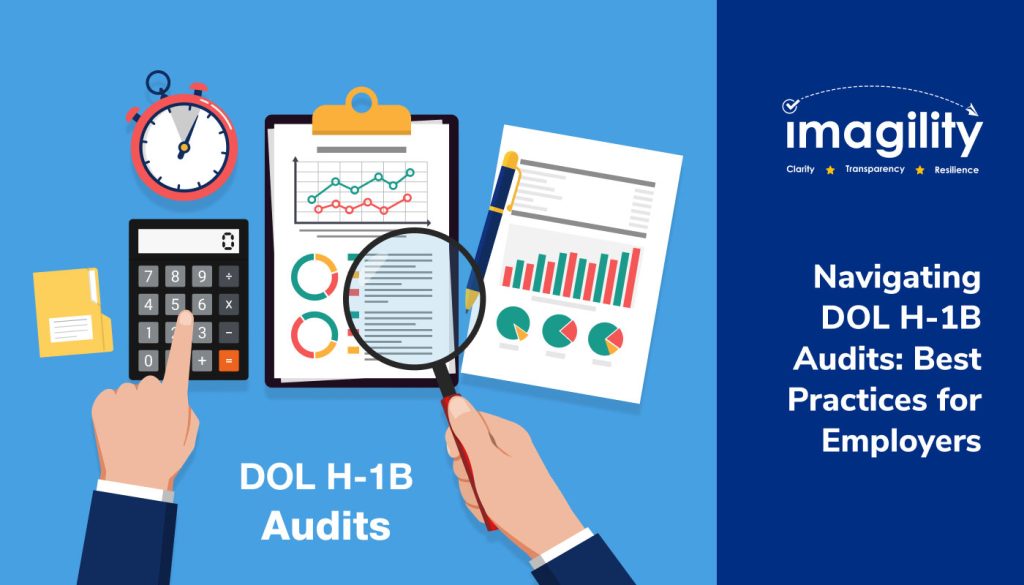Table of Contents
Understanding the DOL H-1B audit process
Comprehensive Documentation Guide
Proactive audit preparation steps
Navigating common audit challenges
Legal advice and compliance solutions
Post-audit response and corrective actions
Summing Up!
The H-1B visa program serves as a vital avenue for U.S. employers to employ foreign nationals in specialty occupations. While the program offers numerous benefits, it also comes with rigorous oversight by the U.S. Department of Labor (DOL). Employers must navigate these DOL H1B audits efficiently to ensure compliance, avoid penalties, and maintain a positive reputation.
In this comprehensive guide, we’ll delve into best practices to help employers navigate DOL H-1B audits successfully.
Understanding the DOL H-1B audit process
An H-1B DOL audit is an investigation conducted by the U.S. Department of Labor (DOL) to ensure that employers who sponsor foreign nationals under the H-1B visa program comply with the program’s regulations and requirements. The H-1B visa program allows U.S. employers to hire foreign workers in specialty occupations. Let’s deep dive into what triggers DOL H1B audits.
What Triggers a DOL H1B Audit?
DOL conducts audits to ensure that employers comply with the terms specified in the Labor Condition Application (LCA), including wage requirements and working conditions.
What is typically an Audit Procedure?
A DOL H1B audit starts with notification followed by documentation requests and on-site visits.
Notification: Employers receive a Notice of Investigation (NOI) indicating the commencement of an audit.
Documentation Request: DOL typically requests specific documents related to H-1B employees, wages, and working conditions.
On-site Visits: In some cases, DOL may conduct on-site visits to verify compliance.
Comprehensive Documentation Guide
Having discussed what triggers a DOL H1B audit, let’s have a look at the documents that need to be updated.
I-9 Forms:
Ensure accurate and updated Form I-9 for each H-1B employee, including re-verification when applicable.
LCA Documentation:
- Maintain a copy of the certified LCA for each H-1B worker.
- Display LCA postings at each worksite for the required period.
Wage Records:
- Document prevailing wage determinations and actual wage rates.
- Maintain payroll records, including wage deductions, bonuses, and benefits.
Employee Files:
- Maintain individual files for each H-1B employee containing relevant documentation such as resumes, job descriptions, and qualifications.
Proactive audit preparation steps
Now, let’s get to DOL H1B audit preparation steps.
Organizing Documents:
- Establish a centralized system to store and organize all H-1B related documents. You can utilize Imagility Compliance software to keep all the documents in place and retrieve them whenever it is required.
- Conduct regular internal audits to identify and rectify potential compliance issues.
Training:
- Train HR personnel and relevant stakeholders on H-1B regulations, compliance requirements, and best practices.
Navigating common audit challenges
Let’s shed some light on the common audit challenges.
Missing Records:
- Implement robust record-keeping practices to ensure all required documents are readily available.
- Conduct internal audits to identify and address gaps in documentation.
Wage Discrepancies:
- Regularly review wage rates to ensure compliance with LCA requirements.
- Consult with legal counsel to address and rectify discrepancies promptly.
Non-compliant Practices:
- Conduct periodic internal reviews to identify and mitigate potential non-compliant practices.
- Implement corrective actions and compliance measures based on audit findings.
Legal advice and compliance solutions
After making efforts, if it is still challenging to keep records updated and maintain internal audits, it’s better to seek legal advice from an immigration attorney. You can engage with experienced immigration attorneys specializing in H-1B compliance and seek legal advice to address audit findings, resolve issues, and implement effective compliance strategies. You can also look for a next-gen compliance solution like Imagility Compliance software.
Post-audit response and corrective actions
After the DOL officers conduct the audits, companies need to look at the post-audit response and corrective actions to be taken.
Response Strategy:
- Designate a response team to coordinate with DOL auditors, gather requested documents, and address inquiries promptly.
Corrective Actions:
- Implement corrective measures based on audit findings to ensure ongoing compliance.
- Develop a comprehensive compliance plan incorporating lessons learned from the audit process.
Summing Up!
Navigating DOL H-1B audits requires meticulous planning, proactive preparation, and a commitment to compliance. By understanding the audit process, maintaining comprehensive documentation, proactively addressing common challenges, seeking legal advice when necessary, and implementing post-audit corrective actions, employers can navigate DOL H-1B audits successfully. Prioritizing compliance not only mitigates risks but also fosters trust, integrity, and responsible business practices in the H-1B visa sponsorship process.
Imagility’s I-9 and Compliance Software, is an intuitive Form I-9 and compliance solution can be directly accessed online or through an integration with your existing HR or payroll system. Imagility Compliance Software helps to ensure actual compliance with current employment eligibility legal requirements and helps to streamline your entire I-9, LCA, PAF, and overall compliance processes for both onsite and remote employees.









